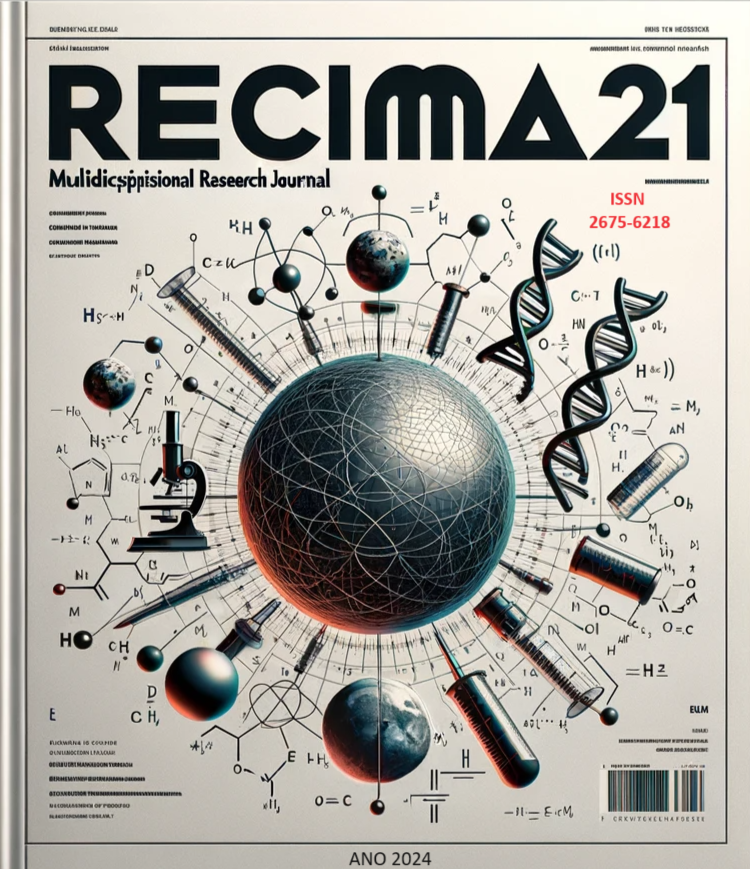VENTILACIÓN MECÁNICA EN PACIENTES CON SÍNDROME DE DIFICULTAD RESPIRATORIA AGUDA (SDRA)
DOI:
https://doi.org/10.47820/recima21.v5i7.5561Palabras clave:
Ventilación mecánica. Síndrome de dificultad respiratoria aguda. Mortalidad.Resumen
Este estudio tuvo como objetivo investigar los efectos generados por el uso de la Ventilación Mecánica (VM) en el tratamiento de pacientes con Síndrome de Distrés Respiratorio Agudo (SDRA). Métodos: Se realizó una revisión integradora de la literatura, la cual se buscó en las bases de datos de la Biblioteca Virtual en Salud (BVS), en la literatura latinoamericana y del Caribe en ciencias de la salud (Lilacs) y en la literatura internacional en ciencias de la salud (Medline); Scientific Electronic Library Online (SciELO) y en el sitio web del National Center for Biotechnology Information (NCBI), en la base de datos PubMed, con solo artículos publicados a partir de 2019, que componen investigaciones originales, siendo utilizados para la revisión de la literatura. Resultados: Se encontró que la personalización de la MV y la eliminación extracorpórea de dióxido de carbono no redujeron la mortalidad en los pacientes, pero el estudio que utilizó el Volumen Marea Bajo (VCB) puede presentar resultados beneficiosos. Además, no se encontró que la eficacia de la presión de conducción limitada (LDP) y el volumen corriente bajo (LTV) fuera significativamente diferente. Además, el nivel de tomografía de impedancia eléctrica (PEEPIT) y la presión transpulmonar positiva al final de la espiración (LPEP) se asocian con una mejoría en los pacientes con SDRA.
Descargas
Citas
ARDS DEFINITION TASK FORCE et al. Acute respiratory distress syndrome: the Berlin Definition. JAMA, v. 307, n. 23, p. 2526–33, jun. 2012. DOI: https://doi.org/10.1001/jama.2012.5669
ARDS NETWORK et al. Ventilation with lower tidal volumes as compared with traditional tidal volumes for acute lung injury and the acute respiratory distress syndrome. The New England journal of medicine, v. 342, n. 18, p. 1301–8, maio 2000. DOI: https://doi.org/10.1056/NEJM200005043421801
BACHMANN, M. C. et al. Electrical impedance tomography in acute respiratory distress syndrome. Critical care (London, England), v. 22, n. 1, p. 263, out. 2018. DOI: https://doi.org/10.1186/s13054-018-2195-6
BARBAS, C. S. V. et al. Ventilação mecânica na crise de asma aguda. J Bras Pneumol., v. 33, Supl 2, p. S 106-S 110, 2007. DOI: https://doi.org/10.1590/S1806-37132007000800005
CARTEAUX, G. et al. Patient-Self Inflicted Lung Injury: A Practical Review. Journal of Clinical Medicine, v. 10, n. 12, p. 2738, jun. 2021. DOI: https://doi.org/10.3390/jcm10122738
CONSTANTIN, J.-M. et al. Personalised mechanical ventilation tailored to lung morphology versus low positive end-expiratory pressure for patients with acute respiratory distress syndrome in France (the LIVE study): a multicentre, single-blind, randomised controlled trial. The Lancet Respiratory Medicine, v. 7, n. 10, p. 870–80, out. 2019.
DELUCCHI, K. et al. Stability of ARDS subphenotypes over time in two randomised controlled trials. Thorax, v. 73, n. 5, p. 439–45, maio 2018. DOI: https://doi.org/10.1136/thoraxjnl-2017-211090
DOUGLAS, W. W. et al. Improved oxygenation in patients with acute respiratory failure: the prone position. The American review of respiratory disease, v. 115, n. 4, p. 559–66, abr. 1977.
ERCOLE, F. F.; MELO, L. S. de; ALCOFORADO, C. L. G. C. Revisão integrativa versus revisão sistemática. REME-Revista Mineira de Enfermagem, [S. l.], v. 18, n. 1, 2014. DOI: https://doi.org/10.5935/1415-2762.20140001
GATES, B. Responding to Covid-19 - A Once-in-a-Century Pandemic? New England Journal of Medicine, v. sn, p. 1–3, abr, 2020. DOI: https://doi.org/10.1056/NEJMp2003762
GATTINONI, L. et al. Lung Recruitment in Patients with the Acute Respiratory Distress Syndrome. New England Journal of Medicine, v. 354, n. 17, p. 1775–86, abr. 2006. DOI: https://doi.org/10.1056/NEJMoa052052
GRIECO, D. L.; CHEN, L.; BROCHARD, L. Transpulmonary pressure: importance and limits. Annals of Translational Medicine, v. 5, n. 14, p. 285–6, jul. 2017. DOI: https://doi.org/10.21037/atm.2017.07.22
HICKLING, K. G. et al. Low mortality rate in adult respiratory distress syndrome using low-volume, pressure-limited ventilation with permissive hypercapnia: A prospective study. Critical Care Medicine, v. 22, n. 10, p. 1568–78, out. 1994. DOI: https://doi.org/10.1097/00003246-199422100-00011
LOSCALZO, Joseph. Pneumologia e Medicina Intensiva de Harrison. Porto Alegre: AMGH Editora, 2014.
MANCEBO, J. et al. A multicenter trial of prolonged prone ventilation in severe acute respiratory distress syndrome. American journal of respiratory and critical care medicine, v. 173, n. 11, p. 1233–9, jun. 2006. DOI: https://doi.org/10.1164/rccm.200503-353OC
MCNAMEE, J. J. et al. Effect of Lower Tidal Volume Ventilation Facilitated by Extracorporeal Carbon Dioxide Removal vs Standard Care Ventilation on 90-Day Mortality in Patients With Acute Hypoxemic Respiratory Failure: The REST Randomized Clinical Trial. JAMA, v. 326, n. 11, p. 1013–23, set. 2021. DOI: https://doi.org/10.1001/jama.2021.21005
ORNICO, S. R. et al. Noninvasive ventilation immediately after extubation improves weaning outcome after acute respiratory failure: A randomized controlled trial. Critical Care, v. 17, n. 2, p. R39, 2013. DOI: https://doi.org/10.1186/cc12549
PÉREZ-CALATAYUD, Ángel Augusto et al. Hallazgos histopatológicos en síndrome de dificultad respiratoria aguda. Med. crít. (Col. Mex. Med. Crít.), Ciudad de México, v. 31, n. 4, p. 218-223, ago. 2017.
PUYBASSET, L. et al. Regional distribution of gas and tissue in acute respiratory distress syndrome. III. Consequences for the effects of positive end-expiratory pressure. CT Scan ARDS Study Group. Adult Respiratory Distress Syndrome. Intensive care medicine, v. 26, n. 9, p. 1215–27, set. 2000. DOI: https://doi.org/10.1007/s001340051340
RICHTER, T. et al. Effect of prone position on regional shunt, aeration, and perfusion in experimental acute lung injury. American journal of respiratory and critical care medicine, v. 172, n. 4, p. 480–7, ago. 2005. DOI: https://doi.org/10.1164/rccm.200501-004OC
SCARAMUZZO, G. et al. Personalized Positive End-Expiratory Pressure in Acute Respiratory Distress Syndrome: Comparison Between Optimal Distribution of Regional Ventilation and Positive Transpulmonary Pressure. Critical care medicine, v. 48, n. 8, p. 1148–56, ago. 2020. DOI: https://doi.org/10.1097/CCM.0000000000004439
SHEN, Y. et al. Interaction between low tidal volume ventilation strategy and severity of acute respiratory distress syndrome: a retrospective cohort study. Critical care (London, England), v. 23, n. 1, p. 254, jul. 2019. DOI: https://doi.org/10.1186/s13054-019-2530-6
TASAKA, S. et al. ARDS Clinical Practice Guideline 2021. Journal of Intensive Care, v. 10, n. 1, p. 32, jul. 2022.
TONGYOO, S. et al. Comparison of limited driving pressure ventilation and low tidal volume strategies in adults with acute respiratory failure on mechanical ventilation: a randomized controlled trial. Therapeutic advances in respiratory disease, v. 18, jan. 2024. DOI: https://doi.org/10.1177/17534666241249152
WRITING GROUP FOR THE PREVENT INVESTIGATORS et al. Effect of a Low vs Intermediate Tidal Volume Strategy on Ventilator-Free Days in Intensive Care Unit Patients Without ARDS: A Randomized Clinical Trial. JAMA, v. 320, n. 18, p. 1872–80, nov. 2018. DOI: https://doi.org/10.1001/jama.2018.14280
Descargas
Publicado
Cómo citar
Número
Sección
Categorías
Licencia
Derechos de autor 2024 RECIMA21 - Revista Científica Multidisciplinar - ISSN 2675-6218

Esta obra está bajo una licencia internacional Creative Commons Atribución 4.0.
Os direitos autorais dos artigos/resenhas/TCCs publicados pertecem à revista RECIMA21, e seguem o padrão Creative Commons (CC BY 4.0), permitindo a cópia ou reprodução, desde que cite a fonte e respeite os direitos dos autores e contenham menção aos mesmos nos créditos. Toda e qualquer obra publicada na revista, seu conteúdo é de responsabilidade dos autores, cabendo a RECIMA21 apenas ser o veículo de divulgação, seguindo os padrões nacionais e internacionais de publicação.

 Clique para ver detalhes
Clique para ver detalhes 











